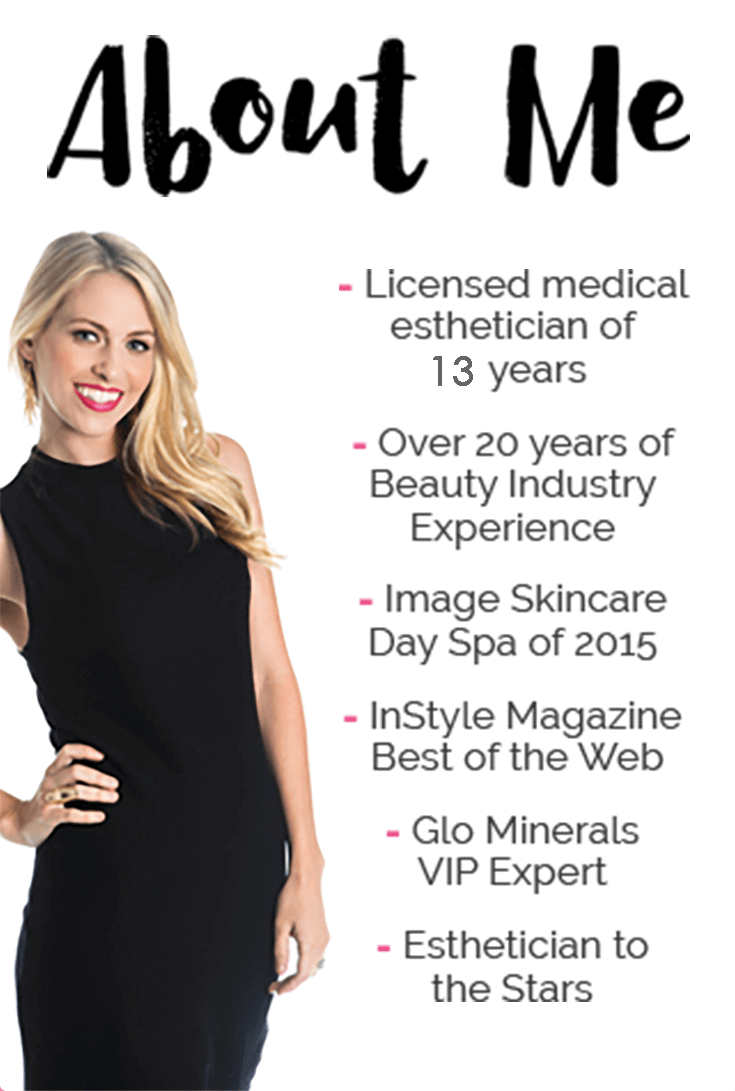What Should You Be Using In Your Skin Care Routine?
Take my quiz and get personalized recommendations from a
licensed esthetician!
Stop Looking All Over the Internet for Cleansing Tips – I’ve Got Them HERE
Happy Wednesday, friends!
As this year draws to a close, I’d like to recap on another skincare trend we saw this year: cleansing.

This is encouraging!
Cleansing can be a part of the beauty routine that we might skimp on, take for granted, or downright ignore.
It’s one area where its super easy to fall into a groove that we never get out of, or even think twice about.
And that can be a dangerous thing to do to your skin!
That’s why another trend over the last few years that I’m happy to see is smarter cleansing solutions with more balanced formulas that actually take your skin’s pH into account.
This is a great move in the right direction.
Remember all those years that Pinterest was swimming in homemade-kitchen-product facial scrub recipes?
Thankfully, that’s all been replaced with a much smarter attention to gentle, effective, and hydrating cleansers that don’t damage the epidermis.

Let’s Talk Science: pH Balance
The growing awareness of the importance of pH balance means harsh cleansers that strip away the skin’s natural defenses and hydration barriers are out. Buh-bye!
Ideally, your skin’s pH balance should be on the acidic side at around 4.7.
(I know, you often read 5.5, but the science says it’s a bit lower.)
This acidic condition keeps the friendly bacteria that live on the skin hanging around, which is good.
Among other things, the surface of the skin has bacterial flora, oil, and enzymes.
All are important to maintaining the thin protective layer called the ‘acid mantle.’
When the acid mantle is disrupted, the skin’s defenses are down, and breakouts and other skin conditions can result.
Harsh detergents in soaps and many cleansers are so far in the alkaline range that they disrupt pH balance and strip away natural oils that help protect your skin and maintain moisture levels.
Many of these products have pH levels around 10, which is too high.
Gentle cleansers and toners without these harsh ingredients have pH levels more in the acidic range, usually around 5.
This level keeps the acid mantle intact.
So, keep reading those labels, my beauties!
And, let’s resolve in 2018 to treat cleansing with the respect and care it deserves.
Not all products are created equal, and some of our cleansing routines can be quick, steeped in old habits, and on the careless side.
I want to give you the low-down on the cleansers you should use, and those to avoid, as well as the best routine to maintain the skin’s delicate pH balance and promote vitality and strength.
Let’s make sure your current routine is best serving your skin.

Types of Cleansers for the Face
Oil-based
Most of us fear oil due to its reputation of causing clogged pores and acne.
However, oil-based cleanser can actually be beneficial for oily, acne-prone skin.
I promise I'm not making this stuff up!
Oil cleansers break down and remove excess sebum, makeup, and sunscreen.
Spread it evenly over your entire face using gentle, circular motions for 1-2 minutes.
This mini self-massage sesh will promote blood circulation (and feel good).
It's especially beneficial right now as circulation decreases in colder climates.
Add a splash of lukewarm water to emulsify, which will help it to wash off easily.
You can also use natural oils, like castor or coconut, but they're more likely to leave behind an oily residue.
It's better to use a specifically formulated oil cleanser for the face.
For a double cleanse, you can follow this step with another facial cleanser of your choice.
Gel
Gel cleansers do a good job at removing excess oils for a deep clean and a fresh feeling.
They're activated by water, so work into a foam and then rinse.
Foaming
Just as the name states, these cleansers foam up and are dispersed from a pump.
This is a versatile cleanser that does well with many skin types.
With the right ingredients, a gentle cleansing foam will remove oil and dirt without upsetting the pH balance of your skin or over-drying.

Cream
Typically, cream cleansers are good for dry and sensitive skin types as the rich formula doesn't deplete moisture.
Some are even great for targeting acne.
Take time to massage the skin and lift out oil, any trapped dirt, or residue with wet hands and then rinse.
Balm
If you're looking for a creamy, rich formula, this one is for you.
These are hydrating cleansers that feel wonderful on skin that’s dry and irritated from the cold temps of winter.
You’ll find one for almost every botanical oil and many delicious blends as well.
There seems to be a balm for any and every purpose right now, so odds are you’ll find one to match your specific skin challenge.
Some are formulated to boost collagen production, and others to calm and soothe irritation.
Many clients fall in love with the spa-like experience of using a cleansing balm.
With such a variety of products, there’s no one-size-fits-all application, but generally, you’ll massage to remove impurities and then wipe off with a damp cloth.
Invest in a muslin cloth for the full effect and get ready to pamper your skin.

Other Types of Cleansing
Wipes
In this on-the-go world, the demand for cleansing wipes is ever-growing.
In fact, the market for this product is expected to steadily grow by about 10 percent per year for the next few years.
My take on this is that when you’re short on time, at least you’re still taking care of your skin.
However, you shouldn't depend on wipes every day, as they don't remove as much as traditional cleansers.
Many use oil-based cleansers, though not all.
Some focus on hydrating, while others focus on toning.
Liquid Makeup Remover
If you're using waterproof mascara and heavy makeup, liquid makeup remover can be a winner.
Soak a cotton round with the remover, then placed it on one closed eye and let it sit there for 10-15 seconds.
This breaks the makeup down and makes it easier to remove so you don't have to tug - which can cause wrinkles.
Use an oil-based formula and DON'T use anything that stings or irritates.
The skin around your eyes is the most delicate on your face.
Liquid makeup remover seems to be getting nudged aside in favor of cleansing oils and micellar water for now, but many still swear by it as an old standby.
If you do use this product, don’t think of it as an all-in-one cleanser, but follow this step with your cleanser of choice.
Micellar Water
This is definitely a trending product as of late!
It's made of tiny balls of cleansing oil molecules, called micelles, that are in soft water.
The micelles attract dirt and oil and easily remove them from the skin, without drying it out.
Simply saturate a cotton ball with the product and swipe it across your skin.
No rinsing is required, so this is another time saver and super popular as a result!
Mists
Essentially, some mists are toners in a spray bottle, while others are designed to have a more hydrating effect.
Look carefully at what you're buying, however.
I’m not against mists and love the refreshing feeling myself, but they tend to be very drying to the skin with overuse.
This is mainly due to confusion over how a mist should function.
Some are meant to be applied between makeup layers; others to set makeup and create a dewy look.
The problem here is that these are normally water-based products.
The water will evaporate and, in the process, will pull moisture out of your skin.
If you’re applying a mist repeatedly throughout the day, your skin is likely suffering.
Having said that, as part of your layered cleansing routine, a mist would work better applied just before moisturizer or serum.
In this case, the oils and emollients of the moisturizer will help seal the water and other health-boosting ingredients like vitamins into your skin.
My personal favorite mists contain hyaluronic acid, for instance.
Electronic Brushes
An electronic brush will work to exfoliate your skin and eliminate excess oil and dirt for a deep clean.
There are so many different types, so make sure to do your research before purchasing.
Like any exfoliating mechanism, you don’t want to overuse, especially if you’re using anti-aging ingredients like retinol that may cause a risk of irritation.
Please be careful to keep your brush clean, store properly, and replace the brush head regularly (every 3 months).
You’ll want to rinse and air-dry after each use.
As you can see, the possibilities for cleansing can be mind-boggling.
But, I hope I’ve helped you narrow down your choices based on your skin type and preferences.
You’ll have fewer categories when it comes to types of cleansers for the body, but still a wealth of variety.

Cleansing Options for the Body
Body Wash
What should you look for in a body wash?
Two words – moisturizing ingredients.
Look for ingredients like cocoa butter, shea butter, and jojoba oil.
I also recommend using products that are paraben-free.
As long as you choose moisturizing body washes, which combine water and detergents with oil and have richer formulas, you won’t dry out and irritate the skin.
Some of the oil in this product will be washed off as you use it in the shower, but some of it will penetrate the skin and lock in water with it.
Shower Gel
Body wash and shower gel are pretty similar - the difference lies in the formula.
Gels are thinner and can be more drying, so they're good for the summer months.
They're made of water, surfactants, and fragrance.
While the surfactant, or detergent, will do the work of removing oil and dirt, it can also disrupt the natural pH balance and dehydrate the skin.

Bar Soap
Bar soap is made from fats and oils that react with lye (sodium hydroxide).
Olive oil, soybean oil, and canola oil make more mild soaps.
Solid fats like coconut oil, palm oil, and lard are harder so they don't dissolve.
Dyes and perfumes are also added.
Bar soap removes dirt, sweat, and oil from the skin and is easy to apply alone or with a washcloth.
However, dry and sensitive skin types should stick to body washes and shower gels as they're water-based and more moisturizing.
If you prefer bar soap, look for one that's organic and has vitamins, amino acids, and nutrients to keep the skin hydrated and healthy.
Loofahs and Manual Brushes
Much like electric brushes, loofahs are great exfoliators.
They can be harder to clean and store safely, however, which leads to the harboring of bacteria.
If you’re conscientious and have a great system for keeping yours clean and dry, go for it, but otherwise, it might best to avoid these.
And, while we’re on the subject of bacteria, the same goes for washcloths!
How Often Should You Wash Your Face?
When it comes to cleansing, don’t skip this critical step in your overall routine - but don’t overdo it, either.
Everyone’s skin is different, but for many of my clients, I recommend a full cleansing routine at night only.
For oily skin types, you might use only a cleansing mist with moisturizer in the morning.
If you choose an oil cleanser or balm with natural ingredients only, some skin types will benefit from an application in the morning as well.
For the majority of skin types I see, once a day is mandatory to remove the dirt and environmental grime of the day, and twice a day is optional (using gentle and safe ingredients).
If you’re showering daily, be sure to use a moisturizing cleanser only on the body and avoid using soaps on the face.
Proper Ways to Wash Your Face
Now, here’s a quick primer on your cleansing routine and a chance to get out of a skin-damaging rut if you’ve fallen into one.
(It’s OK! It happens.)
As a mom, I like to keep things simple, so I promise not to over-complicate this!
Take the following steps at night only, and rinse with lukewarm water when indicated.
- Remove makeup gently.
- Follow with a gentle gel, cream, or foam cleanser to remove any leftover residue.
- Optional exfoliation with a brush or scrub (not mandatory and don’t overdo; 2-3 times a week is safe.)
- Apply a toner (avoid alcohol-based ones) or a nourishing mist.
- Optional face mask once a week.
- Follow immediately with serum (optional) and then moisturizer.
Voila! Clean, nourished, and moisturized skin.
My Favorite Cleansing Products for the Face
Cream: Alana Mitchell Daily OC Cream Cleanser

Foaming: Alana Mitchell Foaming Pumpkin Cleanser
Exfoliating: Alana Mitchell 4-in-1 Cleansing Pods
Oil-Based: Eminence Organics Stone Crop Cleansing Oil
Gel: Image Skincare Clear Cell Salicylic Gel Cleanser
My Favorite Cleansing Products for the Body
Epicuren Tropical Lave Body Wash
June Jacobs Green Tea and Cucumber Cleansing Bar
Final Thoughts
Most of the trends in cleansing I’m seeing are a good sign.
The pH balance of your skin matters, and thankfully this truth is reflected in the newer cleansing products on the market.
Now’s a great time to refresh your cleansing routine and check yourself.
Any ingredients you need to eliminate or areas where you’ve been overdoing it?
Your skin may need a break.
Unless you’re extremely oil-averse, try the oil cleansers that are all the rave and lock in antioxidants, fatty acids, and moisture.
And, finally, keep it simple!
Are you on board with the oil cleanser craze? Tried the straight-up oil cleansing method? Which oil did you choose and how did your skin react? I’d love to hear your experience with that in the comments.
Top Brands
New Brands

Recent Posts

Are You Taking the Right Steps to Care for Your Skin?
Take the Quiz
Skincare Secrets!
10-step guide for healthy, beautiful skin after kids.
100% privacy. I will never spam you!




















